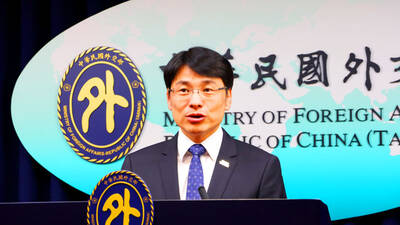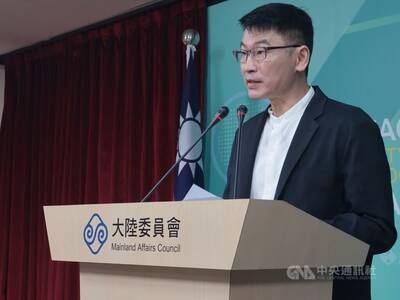The army is in the process of establishing three new mecha-nized infantry brigades, which will become the service's major fighting force in the future, defense sources said yesterday.
The first mechanized infantry brigade is already being formed, while the next two are in the planning stage. The first brigade integrated the Tainan-based 298th motorized infantry brigade with the Pingtung-based 395th armored infantry brigade to form a new type of combat force that the nation's army has never seen before.
The 298th brigade will disappear after the integration. The other two motorized infantry brigades, to be located in the center and north of the country, will soon follow suit.
A senior army official, who spoke on condition of anonymity, said the new mechanized infantry brigade features high mobility and concentrated firepower.
"These brigades will be equip-ped with an eight-wheeled armored vehicle currently under development. They are to become truly mobile forces," the official said.
"The reason for integrating a mobilized infantry brigade with an armored infantry brigade is to concentrate personnel and equipment, which are to become increasingly limited in the next few years as a new wave of personnel streamlining efforts get under way," he said.
In a previous personnel stream-lining program, the Chingshih Project, the 333rd infantry division, of which the 298th brigade forms a part, was reduced to a regional command without any forces under its direct control. The Chingshih Project was completed in 1997.
The three brigades of the division, including the 997th, 998th and 999th brigades, were then detached from the division. Only the 998th brigade has survived, in the form of a motorized infantry brigade renamed the 298th brigade.
But over the past seven years, the three motorized infantry brigades have been found unable to live up to the "motorized" part of their name, since their major form of transportation was marching.

The Japan-Taiwan Exchange Association has cautioned Japanese travelers to be vigilant against pickpockets at several popular tourist spots in Taiwan, including Taipei’s night markets, the Yongkang Street area, Zhongshan MRT Station, and Jiufen (九份) in New Taipei City. The advisory, titled “Recent Development of Concerns,” was posted on the association’s Web site under its safety and emergency report section. It urges travelers to keep backpacks fully zipped and carried in front, with valuables placed at the bottom of the bag. Visitors are advised to be especially mindful of their belongings when taking photos or speaking on the phone, avoid storing wallets and

ENDORSING TAIWAN: Honduran presidential candidate Nasry Afura said that Honduras was ‘100 times better off’ when it was allied with Taipei The Ministry of Foreign Affairs yesterday said it would explore the possibility of restoring diplomatic relations with Honduras based on the principle of maintaining national interests and dignity. The ministry made the remarks in response to reporters’ questions regarding an article titled: “Will Taiwan Regain a Diplomatic Ally?” published in The Diplomat on Saturday. The article said Honduras’ presidential election in November could offer Taiwan the chance to regain an ally, as multiple candidates have promoted re-establishing diplomatic relations with Taiwan. Honduras severed diplomatic ties with Taiwan in March 2023 in favor of Beijing, but since switching its diplomatic recognition,

Scoot announced yesterday that starting in October, it would increase flights between Taipei and Japan’s Narita airport and Hokkaido, and between Singapore and Taipei. The low-cost airline, a subsidiary of Singapore Airlines, also said it would launch flights to Chiang Rai in Thailand, Okinawa and Tokyo’s Haneda airport between December and March next year. Flights between Singapore and Chiang Rai would begin on Jan. 1, with five flights per week operated by an Embraer E190-E2 aircraft, Scoot said. Flights between Singapore and Okinawa would begin on Dec. 15, with three flights per week operated by Airbus A320 aircraft, the airline said. Services between Singapore

The Mainland Affairs Council (MAC) yesterday announced a ban on all current and former government officials from traveling to China to attend a military parade on Sept. 3, which Beijing is to hold to mark the 80th anniversary of the end of the Second Sino-Japanese War. "This year marks the 80th anniversary of the end of World War II and the Republic of China’s victory in the War of Resistance [Against Japan]," MAC Deputy Minister and spokesperson Liang Wen-chieh (梁文傑) told a regular news briefing in Taipei. To prevent Beijing from using the Sept. 3 military parade and related events for "united